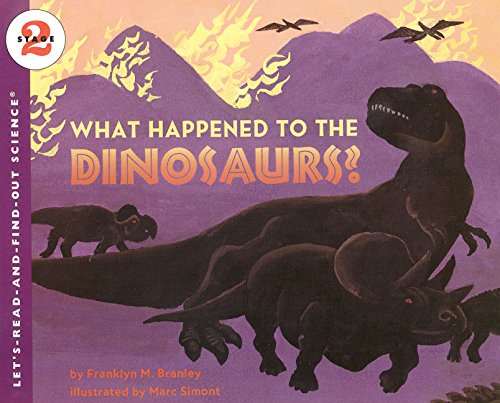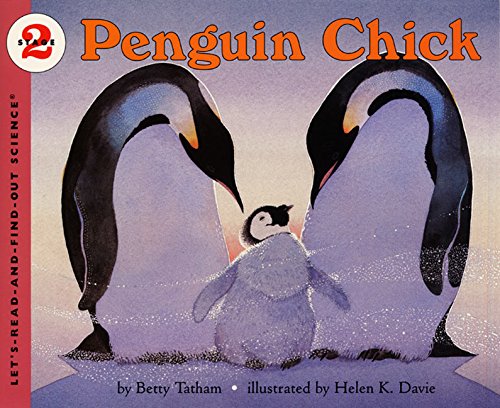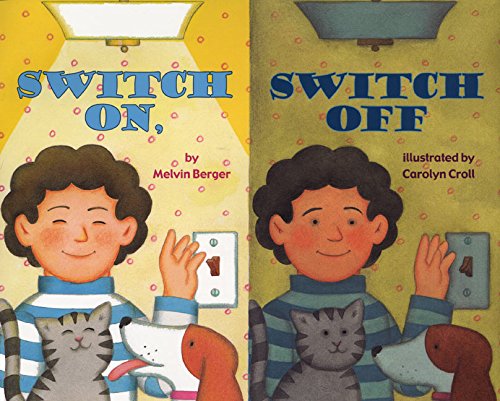-
What Happened to the Dinosaurs?
BRANLEY, Dr. Franklyn M. Branley, Marc Simont
Paperback (HarperCollins, June 21, 2000)In this enlarged edition of the Level 2 Let's-Read-and-Find-Out Science book, distinguished writer Franklyn M. Branley and award-winning artist Marc Simont provide the perfect introduction to an always fascinating subject—the disappearance of the dinosaurs. This nonfiction picture book is an excellent choice to share during homeschooling, in particular for children ages 4 to 6. It’s a fun way to learn to read and as a supplement for activity books for children.What happened to the dinosaurs?For millions of years these fantastic creatures roamed our planet. Then, suddenly, they all disappeared. Scientists wonder why. What could have caused this huge extinction 65 million years ago?This is a Level 2 Let’s-Read-and-Find-Out Science title, which means the book explores more challenging concepts for children in the primary grades and supports the Common Core Learning Standards, Next Generation Science Standards, and the Science, Technology, Engineering, and Math (STEM) standards. Let’s-Read-and-Find-Out is the winner of the American Association for the Advancement of Science/Subaru Science Books & Films Prize for Outstanding Science Series.Outstanding Science Trade Books for Children 1989 (NSTA/CBC) L
L
-
Almost Gone: The World's Rarest Animals
Steve Jenkins
Paperback (HarperCollins, Jan. 31, 2006)Have you seen a northern hairy-nosed wombat or an eastern barred bandicoot? These animals are so rare, they might disappear forever, and they're not alone. Read and find out about some of the animals that are almost gone. This nonfiction picture book is an excellent choice to share during homeschooling, in particular for children ages 5 to 7. It’s a fun way to learn to read and as a supplement for activity books for children.This is a Level 2 Let’s-Read-and-Find-Out Science title, which means the book explores more challenging concepts for children in the primary grades and supports the Common Core Learning Standards, Next Generation Science Standards, and the Science, Technology, Engineering, and Math (STEM) standards. Let’s-Read-and-Find-Out is the winner of the American Association for the Advancement of Science/Subaru Science Books & Films Prize for Outstanding Science Series. R
R
-
Gravity Is a Mystery
Dr. Franklyn M. Branley, Edward Miller
Paperback (HarperCollins, May 29, 2007)What goes up must come down. Everybody knows that. But what is it that pulls everything from rocks to rockets toward the center of the earth? It’s gravity. Nobody can say exactly what it is, but gravity is there, pulling on everything, all the time. With the help of an adventurous scientist and his fun-loving dog, you can read and find out about this mysterious force. This nonfiction picture book is an excellent choice to share during homeschooling, in particular for children ages 5 to 7. It’s a fun way to learn to read and as a supplement for activity books for children.This is a Level 2 Let’s-Read-and-Find-Out Science title, which means the book explores more challenging concepts for children in the primary grades and supports the Common Core Learning Standards, Next Generation Science Standards, and the Science, Technology, Engineering, and Math (STEM) standards. Let’s-Read-and-Find-Out is the winner of the American Association for the Advancement of Science/Subaru Science Books & Films Prize for Outstanding Science Series. M
M
-
Penguin Chick
Betty Tatham, Helen K. Davie
Paperback (HarperCollins, Dec. 18, 2001)An emperor penguin lays an egg on the Antarctic ice. In the bitter cold, miles away from the only source of food, how can the chick survive? A father penguin keeps his mate's egg warm by balancing it on his feet for two entire months. Learn how penguin parents take care of their babies in one of Earth's coldest, most desolate environments. This nonfiction picture book is an excellent choice to share during homeschooling, in particular for children ages 5 to 7. It’s a fun way to learn to read and as a supplement for activity books for children.This is a Level 2 Let’s-Read-and-Find-Out Science title, which means the book explores more challenging concepts for children in the primary grades and supports the Common Core Learning Standards, Next Generation Science Standards, and the Science, Technology, Engineering, and Math (STEM) standards. Let’s-Read-and-Find-Out is the winner of the American Association for the Advancement of Science/Subaru Science Books & Films Prize for Outstanding Science Series. O
O
-
Where Do Chicks Come From?
Amy E Sklansky, Pam Paparone
Paperback (HarperCollins, Feb. 1, 2005)Read and find out all about eggs—and how baby chicks grow inside of them. Learn how chicks develop,how they get the food they need to grow, and how a mother hen helps keep them safe in this simple introduction to the life cycle of a baby chick. This nonfiction picture book is an excellent choice to share during homeschooling, in particular for children ages 4 to 6. It’s a fun way to learn to read and as a supplement for activity books for children.This is a Level One Let’s-Read-and-Find-Out Science title, which means the book explores more challenging concepts for children in the primary grades and supports the Common Core Learning Standards, Next Generation Science Standards, and the Science, Technology, Engineering, and Math (STEM) standards. Let’s-Read-and-Find-Out is the winner of the American Association for the Advancement of Science/Subaru Science Books & Films Prize for Outstanding Science Series. N
N
-
What the Moon is Like
Dr. Franklyn M. Branley, True Kelley
Paperback (HarperCollins, May 3, 2000)Imagine that you're walking on the moon. What is it like? For thousands of years people looked up at the moon and wondered about it. Now we know what the moon is like. There is no air on the moon and nothing grows, but there are towering mountains and deep craters—and much more! Colder than the desert, the hotter than the desert, the moon is an amazing place to explore. This nonfiction picture book is an excellent choice to share during homeschooling, in particular for children ages 5 to 7 who are ready to read independently. It’s a fun way to keep your child engaged and as a supplement for activity books for children.This is a Level 2 Let's-Read-and-Find-Out Science book, which means the book explores more challenging concepts perfect for children in the primary grades and supports the Common Core Learning Standards and Next Generation Science Standards. Let's-Read-and-Find-Out is the winner of the American Association for the Advancement of Science/Subaru Science Books & Films Prize for Outstanding Science Series. N
N
-
From Seed to Pumpkin
Wendy Pfeffer
Paperback (HarperCollins, Dec. 31, 2012)Pumpkins can be baked in a pie, carved into jack-o'-lanterns, and roasted for a healthy snack. But how does a tiny seed turn into a big pumpkin? With clear text and detailed, colorful illustrations, this book explains what a pumpkin seed needs to help it grow! This book also includes delicious pumpkin recipes and easy experiments to do with pumpkin seeds. This is a Stage 1 Let’s-Read-and-Find-Out, which means the book explains simple science concepts for preschoolers and kindergarteners. Let’s-Read-And-Find-Out is the winner of the American Association for the Advancement of Science/Subaru Science Books & Films Prize for Outstanding Science Series. Supports the Common Core Learning Standards and Next Generation Science Standards L
L
-
Pop! A Book About Bubbles
Kimberly Bradley, Margaret Miller
Paperback (HarperCollins, Sept. 4, 2001)This Stage 1 Let’s-Read-and-Find-Out book explains how trapping air inside soapy liquid creates bubbles—and why bubbles are always round. Blowing bubbles is a staple activity of preschool and kindergarten, and here we introduce a bit of science to go with this popular activity. This nonfiction picture book is an excellent choice to share during homeschooling, in particular for children ages 4 to 6. It’s a fun way to learn to read and as a supplement for activity books for children.What are bubbles made of? Why are they always round? Read and find out about the science behind soap bubbles, and learn why bubbles always go POP!This is a Level One Let’s-Read-and-Find-Out Science title, which means the book explores more challenging concepts for children in the primary grades and supports the Common Core Learning Standards, Next Generation Science Standards, and the Science, Technology, Engineering, and Math (STEM) standards. Let’s-Read-and-Find-Out is the winner of the American Association for the Advancement of Science/Subaru Science Books & Films Prize for Outstanding Science Series. J
J
-
Oil Spill!
Melvin Berger, Paul Mirocha
Paperback (HarperCollins, April 30, 1994)Did you know that an oil spill occurs somewhere in the world almost every day of the year? Oil spills can have many different causes, but the result is the same. Oil harms plants and wildlife that make the oceans and coastlines their home. Scientists are learning the best ways to combat oil spills. Learn how you can help, too! This nonfiction picture book is an excellent choice to share during homeschooling, in particular for children ages 4 to 6. It’s a fun way to learn to read and as a supplement for activity books for children.This is a Level 2 Let’s-Read-and-Find-Out Science title, which means the book explores more challenging concepts for children in the primary grades and supports the Common Core Learning Standards, Next Generation Science Standards, and the Science, Technology, Engineering, and Math (STEM) standards. Let’s-Read-and-Find-Out is the winner of the American Association for the Advancement of Science/Subaru Science Books & Films Prize for Outstanding Science Series. L
L
-
Pinocchio Rex and Other Tyrannosaurs
Melissa Stewart, Steve Brusatte, Julius Csotonyi
Paperback (HarperCollins, Nov. 7, 2017)Everyone knows that Tyrannosaurus rex is the huge dinosaur with sharp claws and tiny arms. But in this appealing level 2 picture book from acclaimed science writer Melissa Stewart, you’ll learn that T. rex is not the only tyrannosaur that existed in prehistoric times. This nonfiction picture book is an excellent choice to share during homeschooling, in particular for children ages 4 to 6. It’s a fun way to learn to read and as a supplement for activity books for children.In the last fifteen years, scientists have found many tyrannosaurs, including one with a really long pointy nose. The New York Times bestselling coauthor of this book, Dr. Steve Brusatte, went to China in order to help ID the dinosaur that he would give the nickname Pinocchio Rex!This book is the perfect overview of the exciting new discoveries in the land of tyrannosaurs. Read and find out how tyrannosaurs evolved—from the tiny Dilong to the enormous T. rex. The book also includes an infographic, activity, and glossary, as well as “Dr. Steve Says” sidebars that give readers insight into what it felt like for Dr. Steve to be involved with the discovery of P. Rex! This is a Level 2 Let’s-Read-and-Find-Out Science title, which means the book explores more challenging concepts for children in the primary grades and supports the Common Core Learning Standards, Next Generation Science Standards, and the Science, Technology, Engineering, and Math (STEM) standards. Let’s-Read-and-Find-Out is the winner of the American Association for the Advancement of Science/Subaru Science Books & Films Prize for Outstanding Science Series. M
M
-
Be a Friend to Trees
Patricia Lauber, Holly Keller
Paperback (HarperCollins, Jan. 30, 1994)Why should you be a friend to trees? Trees are a valuable natural resource. People depend on trees for food, and animals depend on trees for food and shelter. But most important, we depend on trees because they add oxygen, a gas we all need, to the air. While trees give us many wonderful products, we must also protect them because we can't live without them. This nonfiction picture book is an excellent choice to share during homeschooling, in particular for children ages 4 to 6. It’s a fun way to learn to read and as a supplement for activity books for children.This is a Level 2 Let’s-Read-and-Find-Out Science title, which means the book explores more challenging concepts for children in the primary grades and supports the Common Core Learning Standards, Next Generation Science Standards, and the Science, Technology, Engineering, and Math (STEM) standards. Let’s-Read-and-Find-Out is the winner of the American Association for the Advancement of Science/Subaru Science Books & Films Prize for Outstanding Science Series. K
K
-
Switch On, Switch Off
Melvin Berger, Carolyn Croll
Paperback (HarperCollins, Sept. 4, 2001)It seems like magic! It's not—it's electricity. But how does a light actually work? In this clear and simple book learn all about electricity, how it's produced, and how it can be used. At the end you'll learn how to conduct fun experiments that will let you generate electricity yourself! This nonfiction picture book is an excellent choice to share during homeschooling, in particular for children ages 4 to 6. It’s a fun way to learn to read and as a supplement for activity books for children.This is a Level 2 Let’s-Read-and-Find-Out Science title, which means the book explores more challenging concepts for children in the primary grades and supports the Common Core Learning Standards, Next Generation Science Standards, and the Science, Technology, Engineering, and Math (STEM) standards. Let’s-Read-and-Find-Out is the winner of the American Association for the Advancement of Science/Subaru Science Books & Films Prize for Outstanding Science Series. L
L